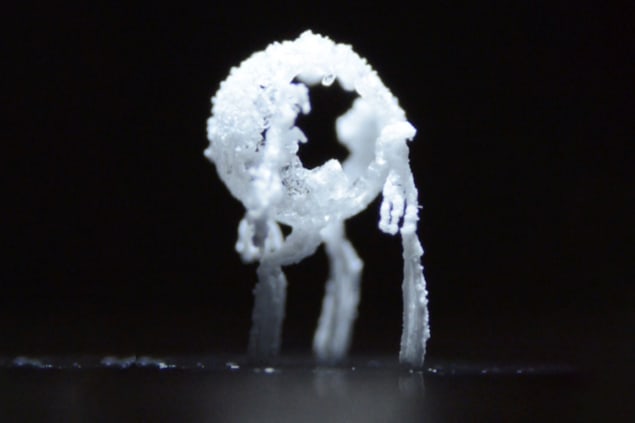
Globules of crystallizing minerals can spontaneously eject themselves from a salt solution as they evaporate. This unexpected phenomenon, which was observed by researchers at the Massachusetts Institute of Technology (MIT), might be harnessed to prevent damage to pipes and other structures in prolonged contact with seawater. According to study leader Kripa Varanasi, the effect might even allow untreated salty water to be used in certain industrial cooling systems.
When precipitants such as salts and other dissolved minerals accumulate on a material, damage known as crystal or mineral fouling frequently results. This damage poses a problem for water treatment, thermoelectric power production and many other industrial processes. Not only does it lower the efficiency of these processes, it also necessitates often expensive solutions, such as water pre-treatment, to counter the effect.
Spindly “leg-like” structures
In their new work, Varanasi and his colleagues Samantha McBride and Henri-Louis Girard studied how 5 μl water drops containing sodium chloride (NaCl) evaporate from a superhydrophobic surface heated to 90 °C. This surface, or “nanograss” as they call it, is covered in nano-sized pointed features and valleys.
They found that during evaporation, the evaporating salts initially form a spherical globe around a droplet – nothing unusual there. During the last stage of evaporation, however, the researchers were surprised to see these spherical shells suddenly lift themselves up on spindly leg-like structures from different contact points on the surface. The process then repeats, producing multilegged shapes that (depending on how you look at them) resemble an octopus, an elephant or jellyfish. The researchers call these structures “crystal critters”.
The narrow legs supporting these critters continue to grow upwards from the contact points until all the water in the drop has evaporated. The legs then begin to taper off, as there is less water (and therefore less dissolved salt) near the end of the evaporation process, until the structure resembles an icicle balanced on its tip. Eventually, the legs become so long that they cannot support the critter’s weight, so the critter breaks off and falls away.
Controlled critter ejection
The researchers found that the rate at which the crystallized protrusions grow increases with temperature. This suggests that the lift-off process could be accelerated to minimize the time the crystals spend on the surface. The researchers also showed that they could make the critters roll in a specific direction by creating heat gradients across the surface. Because the legs grow shorter on the side that is cooler (and longer on the side that is warmer), the crystal structure tends to tip and roll in the direction of lower temperature over time. As the remaining water continues to evaporate, new legs then form at the crystal’s second location. Indeed, crystal structures can roll two or even three times before the drop fully evaporates.
The effect also depends on the texture and length scale of the features on the hydrophobic surface, McBride explains. If these parameters are not carefully controlled, the saltwater drop will simply become trapped inside the nanotexture and form a sphere without ever lifting up. For example, a nanograss with ridges measuring between 0.1 and 1 μm forms critters, but one with regularly spaced microposts 10 μm long shows no vertical growth or self-ejection, despite having a contact angle similar to the one with the nanograss texture. Experiments on a superhydrophobic microhole substrate with 10 μm square holes also failed to form crystal critters, McBride says.
Limiting scaling formation
Varanasi, a mechanical engineer, suggests the newly discovered effect could help limit the formation of mineral scale inside pipes, where it can cause blockages. It could also be useful for other metal structures in a marine environment or that are exposed to seawater on land. For example, heat exchangers become much less efficient when their surfaces are fouled, and Varanasi notes that surface fouling is a major issue in water distribution pipes, geothermal wells, desalination plants and many renewable energy systems.

Barnacles are no match for mushroom-shaped microstructures
“The good news is that the methods for making the textured superhydrophobic surfaces are already well developed, so implementing the effect we have observed on the industrial scale should be relatively rapid,” Varanasi says. He adds that exploiting the effect could even make it possible to use salty water for cooling systems that would otherwise require valuable and often limited freshwater supplies. Using seawater for cooling where possible would, of course, be better for the environment.
The researchers, who report their work in Science Advances, say they now plan to continue studying the unusual self-ejection in other nanotextured materials. “This will allow us to better understand how to implement the effect in real-world systems, including heat exchange surfaces,” Varanasi tells Physics World.



